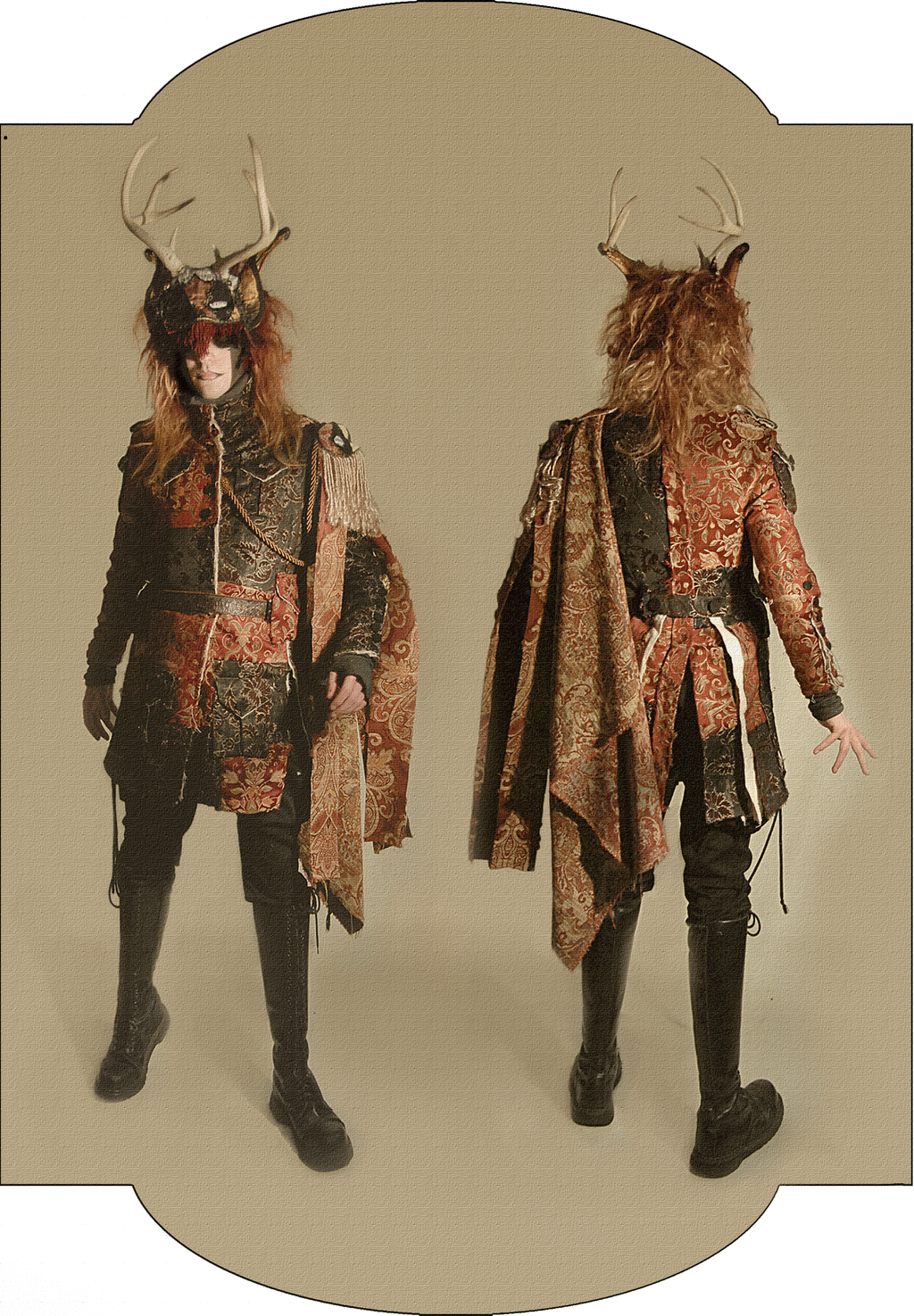ShopDreamUp AI ArtDreamUp
Deviation Actions
Daily Deviation
Daily Deviation
January 2, 2013
Endless Forest Themed Costume Design by *DustinPanzino Suggester Said: Out of all the clothing and custom design I see on DA, this is one of my favorites, Also it would be nice to see that medium of art get more attention on DA!
Featured by princepal
Suggested by TheEnchantedWorld
Suggested Deviants
Suggested Collections
You Might Like…
Featured in Groups
Description
This Is a outfit that I made quite a while ago, But I’ve done a little work on it so it would be ready for Anime Boston, and maybe The Devil Carnival as well.
Those are real antlers, I do most of my casting from them for my other projects, Also the side cape is detachable, it’s magnetic so easy on and off. I also have a flag that goes with this outfit I don’t normally use it thought it’s very tall.
Also the The mask on my head isn’t a mask it’s a head dress you can’t see though it at all! XD and the boots and pants I didn’t make, but other then that everything else is handmade by me =]
More Views [link]
also used in
Facebook [link]
You may NOT use, alter, edit, or manipulate my work in any way. with out my written permission.


© Inkwell illustrations 2012
 Dustin Panzino
Dustin Panzino
Those are real antlers, I do most of my casting from them for my other projects, Also the side cape is detachable, it’s magnetic so easy on and off. I also have a flag that goes with this outfit I don’t normally use it thought it’s very tall.
Also the The mask on my head isn’t a mask it’s a head dress you can’t see though it at all! XD and the boots and pants I didn’t make, but other then that everything else is handmade by me =]
More Views [link]
also used in

Facebook [link]
You may NOT use, alter, edit, or manipulate my work in any way. with out my written permission.
© Inkwell illustrations 2012
Image size
1854x2670px 7.67 MB
© 2012 - 2024 DustinPanzino
Comments210
Join the community to add your comment. Already a deviant? Log In
The star-nosed mole (Condylura cristata) is a small mole found in wet low areas of eastern Canada and the northeastern United States, with records extending along the Atlantic coast as far as extreme southeastern Georgia.[3] It is the only member of the tribe Condylurini and the genus Condylura.
The star-nosed mole is easily identified by the 11 pairs of pink fleshy appendages ringing its snout, which is used as a touch organ with more than 25,000 minute sensory receptors, known as Eimer's organs, with which this hamster-sized mole feels its way around. With the help of its Eimer's organs, it may be perfectly poised to detect seismic wave vibrations.
Description
The star-nosed mole is covered in thick, blackish-brown, water-repellent fur, and has large, scaled feet and a long, thick tail, which appears to function as a fat storage reserve for the spring breeding season. Adults are 15 to 20 cm (5.9 to 7.9 in) in length, weigh about 55 g (2 oz), and have 44 teeth. The mole's most distinctive feature is a circle of 22 mobile, pink, fleshy tentacles called rays at the end of the snout, from which it derives its name. These are used to identify food by touch, such as worms, insects and crustaceans.
The extremely sensitive nasal tentacles are covered with minute touch receptors known as Eimer's organs. The nose is about 1 cm in diameter with roughly 25,000 Eimer's organs distributed on 22 appendages.[5] Eimer's organs were first described in the European mole in 1871 by German zoologist Theodor Eimer. Other mole species also possess Eimer's organs, though they are not as specialized or numerous as in the star-nosed mole. Because the star-nosed mole is functionally blind, the snout was long suspected to be used to detect electrical activity in prey animals,[6] though little, if any, empirical support has been found for this hypothesis. The nasal star and dentition of this species appear to be primarily adapted to exploit extremely small prey. A report in the journal Nature gives this animal the title of fastest-eating mammal, taking as short as 120 milliseconds (average: 227 ms) to identify and consume individual food items.[7] Its brain decides in the ultra short time of 8 ms if a prey is edible or not. This speed is at the limit of the speed of neurons.
These moles also possess the ability to smell underwater, accomplished by exhaling air bubbles onto objects or scent trails and then inhaling the bubbles to carry scents back through the nose.[8]
[edit]
Ecology and behavior
The star-nosed mole lives in wet lowland areas and eats small invertebrates, aquatic insects, worms, mollusks, small amphibians and small fish[9] It is a good swimmer and can forage along the bottoms of streams and ponds. Like other moles, this animal digs shallow surface tunnels for foraging; often, these tunnels exit underwater. It is active day and night and remains active in winter, when it has been observed tunneling through the snow and swimming in ice-covered streams. Little is known about the social behavior of the species, but it is suspected to be colonial.
The star-nosed mole mates in late winter or early spring, and the female has one litter of typically four or five young in late spring or early summer. However, females are known to have a second litter if their first is unsuccessful. At birth, each offspring is about 5 cm long, hairless, and weighs about 1.5 g. Their eyes, ears, and star are all sealed, only opening and becoming useful about 14 days after birth. They become independent after about 30 days, and are fully mature after 10 months. Predators include the red-tailed hawk, great horned owl, various skunks and mustelids, and large fish, as well as domestic cats.
[edit]
Snout comparison to visual organ
Vanderbilt University neuroscientist Kenneth Catania, who has studied star-nosed moles for 20 years, recently turned his research to the study of star-moles as a route to understanding general principles about how human brains process and represent sensory information. He called star-moles "a gold mine for discoveries about brains and behavior in general—and an unending source of surprises".
Comparing the moles snout to vision, his research showed that whenever the mole touched potential food it made a sudden movement to position the smallest rays, the twin rays number 11, over the object for repeated rapid touches. He reports: "The similarities with vision were striking. The star movements resembled saccadic eye movements—quick movements of the eyes from one focus point to another—in their speed and time-course. The two 11th rays are over-represented in primary somatosensory cortex relative to their size, just as the small visual fovea in primates—a small region in the center of the eye that yields the sharpest vision—is over-represented in primary visual cortex." He notes that some bats also have an auditory fovea for processing important echolocation frequencies, suggesting that "evolution has repeatedly come to the same solution for constructing a high-acuity sensory system: subdivide the sensory surface into a large, lower-resolution periphery for scanning a wide range of stimuli, and a small, high-resolution area that can be focused on objects of importance".[10]
[edit]
Snout as related to optimal foraging theory
According to optimal foraging theory organisms forage in such a way as to maximize their net energy intake per unit time. In other words, they behave in such a way as to find, capture and consume food containing the most calories while expending the least amount of time possible in doing so. With extremely short handling times for eating very small prey, star-moles can profitably consume foods that are not worth the time or effort of slower animals, and to have a food category to themselves is a big advantage. Furthermore, just behind the 11th ray of the star, the star-mole has modified front teeth that form the equivalent of a pair of tweezers. High-speed video shows these specialized teeth are used to pluck tiny prey from the ground. Neuroscientist Kenneth Catania reports, "It is also clear from the behavior that the teeth and the star act as an integrated unit—the 11th rays, located directly in front on the teeth, spread apart as the teeth move forward to grasp small food. Thus, tweezer-like teeth and the exquisitely sensitive star likely evolved together as a means to better find and handle small prey quickly...it appears that the ability to rapidly detect and consume small prey was the major selective advantage that drove the evolution of the star."




































